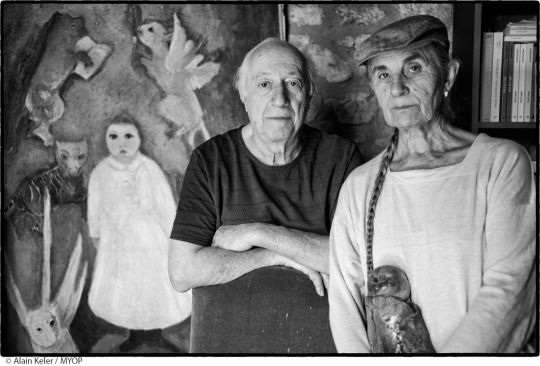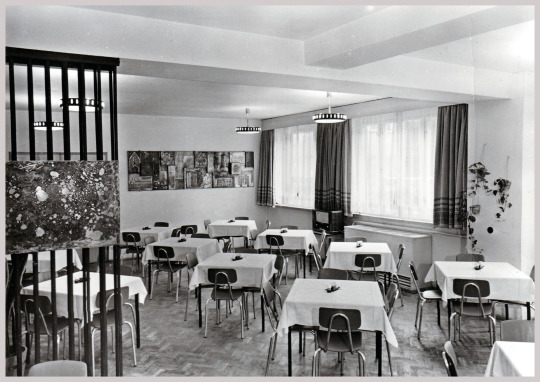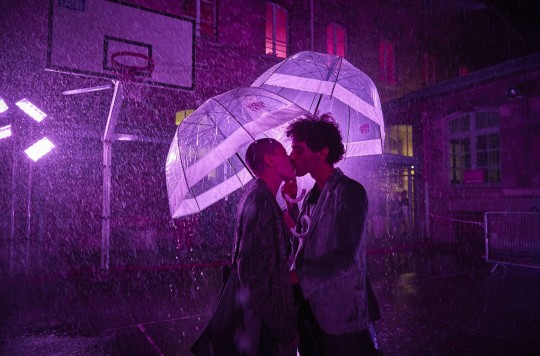#jacques decour
Photo

Paul Éluard, Critique de la poésie, ca. 1943
Le feu réveille la forêt
Les troncs les cœurs les mains les feuilles
Le bonheur en un seul bouquet
Confus léger fondant sucré
C’est toute une forêt d’amis
Qui s’assemble aux fontaines vertes
Du bon soleil du bois flambant
Garcia Lorca a été mis à mort
Maison d’une seule parole
Et de lèvres unies pour vivre
Un tout petit enfant sans larmes
Dans ses prunelles d’eau perdue
La lumière de l’avenir
Goutte à goutte elle comble l’homme
Jusqu’aux paupières transparentes
Saint-Pol-Roux a été mis à mort
Sa fille a été suppliciée
Ville glacée d’angles semblables
Où je rêve de fruits en fleur
Du ciel entier et de la terre
Comme à de vierges découvertes
Dans un jeu qui n’en finit pas
Pierres fanées murs sans écho
Je vous évite d’un sourire
Decour a été mis à mort
#manuscript#poetry#handwriting#paul éluard#federico garcía lorca#jacques decour#saint pol roux#pierre paul roux#1940s
45 notes
·
View notes
Photo

Mardi 19 juillet 2022.
On entend beaucoup pester contre les réseaux sociaux, souvent avec raison, mais ils amènent aussi des surprises. Ils peuvent se transformer en machines à remonter le temps.
J’ai retrouvé un ami du lycée Jacques Decour, Christian Bontzolakis par Facebook que je fréquente pas mal. Christian et moi avions traversé les classes de la 6ème à la 4ème. Christian habitait 20-22 rue Richer et moi au 17 rue de Trévise. Le père de Christian était médecin et sa mère Colette Bonzo peintre de talent. J’étais souvent invité pour des « quatre heures » ou Colette nous servait entre autres du pain d’épice « parfumé » dont je vantais la qualité à mes parents lorsque je rentrais à leur atelier voisin. Avec Christian nous avions fait un journal écrit à la main, le Reflet de l’actualité, puis le Journal du monde, ou l’inverse. Christian écrivait les articles, je mettais en page avec des gros titres, comme les « une de journaux » que j’ai collectionné par la suite.
Nous nous sommes revu la dernière fois en 1968 pendant les évènements de mai. Je travaillais alors dans le laboratoire d’un journal professionnel « Informations Chimie », dont le rédacteur en chef était le voisin de mes parents, qui avaient emménagé dans la maison de leurs rêves à Igny. Ce travail avait pour finalité l’achat d’appareils photo et de voyager autour du monde, ce que je fis peu après avoir été avec Christian aux beaux-arts occupés par les étudiants. Un reportage mêlant le texte de Christian et une ou deux de mes photos fut publié. Peu de temps après je quittais la France et je perdis tout contact avec lui, jusqu’à ces retrouvailles samedi dernier, cinquante-quatre ans plus tard.
Retrouvailles simples et émouvantes de deux personnes éloignées par le temps. Christian est devenu journaliste, écrivain* et homme de théâtre. Il anime avec sa compagne artiste plasticienne Martine Diersé le château et jardin du Pin, à Fabras en Ardèche, un site magnifique dédié au paysage, au patrimoine et à l’art contemporain, avec le travail de Martine et d’artistes invités dans ce château acquis par les parents de Christian dans les années 50 ou 60. Il y a beaucoup de tableaux de Colette, sa mère, que j’entrevoyais lorsque je me rendais chez eux.
Martine travaille la céramique, le voile de béton, la gravure et beaucoup le jardin du château qu’elle a aménagé en jardin de fée, et qui est labellisé en tant que jardin d’artiste depuis 2010. C’est à Fabras, en Ardèche. Le château du pin.
Livres de Christian
Christian Bonzolakis,Théâtres, éditions du Pin, 2007
Les chasseurs, Kallima éditeur 2017
Colette Bonzo, éditions du Pin, 2007
Fabras, c’est une ile ? 2003
Le livre des jardins du Pin, Kallima éditeur, 2011. Gravures et dessins de Martine Diersé.
Dames de la mer, portraits de navigatrices, avec Alain Zimmeroy. 2009, Marines éditions Rennes, 2009.
9 notes
·
View notes
Text
0 notes
Video
A Day at the Lycée Jacques-Decour by Tom Gore
Via Flickr:
with Aim Model in Paris
0 notes
Text
KIBBUTZ CONTEMPORARY DANCE COMPANY | ASYLUM
⚡️La Kibbutz Contemporary Dance Company est en tournée en France avec "Asylum" et vient électriser la scène du Festival Paris l'été, pour les premiers temps forts du festival.
👯 Une pièce collective qui dégage une puissance d'une grande beauté dans les mouvements et la sensualité des danseurs, baignés dans une création lumière à couper le souffle.
⏰Du 12 au 15 juillet
📍Au lycée Jacques Decour
🔖 Pour réserver : https://www.parislete.fr/fr/le-programme/asylum_1
0 notes
Text
Original mars Federal security wanted Rebel Leader Kuato Lives shirt
Concurrent with the Original mars Federal security wanted Rebel Leader Kuato Lives shirt moreover I love this “Teenage Dirtbag” meme on social channels are high school reveries on the catwalk that go beyond candy-colored Mean Girls suits. There was a preppy/boyish thread that ran through the spring 2023 men’s shows that was enlivened by skateboards at JW Anderson and ERL. Meryll Rogge, from Belgium, leaned into the jock (as depicted by Hollywood); prom looks were played with at Thom Browne. Then there was All-In’s Debutante collection, presented at the Collège-lycée Jacques-Decour in Montmartre that was a reasonable stand-in for a smells-like-teen-spirit gym in Anytown, America. Benjamin Barron and Bror August, from the U.S. and Norway, respectively, and based in Paris, are the designers behind this upcycling label that’s something of an insider’s secret. Maryam Nassir Zadeh was an early supporter; Lotta Volkova modeled in last season’s couture-inspired collection; and Inti Wang, Leon Dame, Issa Lish, and Ceval were some of the faces who joined the coming out party for spring today. (Among the “chaperones” at this event was the Swedish Fashion Council who have been helping the designers structure the brand as part of their talent incubator program.)

0 notes
Photo

It was the misfortune, or perhaps privilege, of the critic, writer and professor Sylvère Lotringer, who has died aged 83, to be best known not as the man who launched postmodern French theory to America, but for his supporting role in his second wife’s 1997 semi-fictional epistolary memoir about her erotic obsession with another man.
In I Love Dick, later turned into an Amazon series with Griffin Dunne as Lotringer, the French professor goes on sabbatical to California, accompanied by his wife Chris Kraus, an experimental film-maker, who falls in love with the eponymous academic, modelled on the British critic Dick Hebdige. Lotringer joins the correspondence, signing himself in one letter as Charles Bovary, casting himself thereby as cuckolded husband to Emma Bovary and Dick as her lover Léon Dupuis.
The couple invite Dick to join what amounts to a postmodern art project that blurs fiction and reality. The project would involve pasting the letters in the correspondence on his car and around his house. “It seems to be a step toward the confrontational performing art you’re encouraging,” Lotringer writes to Dick at one point. In reality, Hebdige issued unsuccessful cease and desist letters.
Kraus and Lotringer publicised the book by reading from their letters to Dick on radio shows, never qualifying the correspondence as fiction but rather the letters as fiction: they were, they explained, piercing the false conceit of literature that protected the privacy of the author. The I Love Dick project was French postmodern theory in action, since the couple conceived it as akin to the feminist art stalking projects of the postmodernist artist Sophie Calle, who was Jean Baudrillard’s student. Baudrillard, for his part, was one of the philosophers whom Lotringer introduced to the US and with whom he collaborated on several books.
Lotringer was founding editor in 1974 of the postmodern theoretical journal and publishing house Semiotext(e), which enabled Lotringer to work, as he put it, as a “foreign agent provocateur” bringing together French theory and contemporary American art to fruitful collaboration. The project did not always work well. In 1975, he organised a conference, Schizo-culture, in New York, at which French postmodernist and poststructuralist philosophers for the first time met American artists, along with radical political groups including the Black Panthers.
Michel Foucault lectured on repression, while John Cage performed the chance-generated piece Empty Words. But fights broke out, speakers insulted each other, and Foucault was accused from the floor of being a CIA agent. The psychoanalyst Félix Guattari announced just before his panel: “I am the chair of this panel and I abolish this panel,” and then left. And yet, this conference and Semiotext(e), both Lotringer’s ideas, profoundly changed American intellectual and artistic cultures, for good or ill.
Lotringer was born in Paris, to Polish Jewish immigrants, Doba (nee Borenstein) and Cudek Lotringer, who ran a fur shop. Sylvère and his older sister, Yvonne, were the only Jewish pupils at their school. After enduring the Nazi occupation of Paris, the Lotringers emigrated to Tel Aviv in the new state of Israel in 1949.
There Sylvère joined Hashomer Hatzair, a socialist-Zionist youth movement and experienced life in a kibbutz called Bar Am. “[We] shared everything … Socialism was a reality,” he recalled. It was a collective idyll he sought to recapture in his later life. He and his family returned to Paris and, after graduating from the Lycée Jacques Decour, he studied for a BA (1962) and an MA (1963) in comparative literature from the Sorbonne.
He then enrolled at the Ecole Pratique des Hautes Etudes, where he studied with Lucien Goldmann and Roland Barthes. His doctoral thesis, defended in 1967 and written with assistance from Leonard Woolf, whom he met while carrying out research in Britain, and following conversations with Clive Bell, TS Eliot and Vita Sackville-West, was entitled: Virginia Woolf: De la Mort des Valeurs aux Valeurs de la Mort (“From the Death of Values to the Values of Death”).
“I got my PhD as a way of postponing the draft,” said Lotringer. “Algeria was our Vietnam, and I wasn’t exactly keen on being sent there.” Indeed, at the Sorbonne he had led student protests against France’s colonial war.
Lotringer taught for two years (1965 to 1967) for the French government’s Cultural Services in Turkey. He went to the US in 1969 to become assistant professor of French at Swarthmore College, Pennsylvania, before joining the comparative literature faculty at Columbia University in New York in 1972. Even though he taught there until his retirement in 2009, he claimed to find academia increasingly stultifying: “The student rebellion was only four years [past] and no one dared [mention] it any more.”
Founding Semiotext(e) was a liberation. He recalled that one early issue of the journal was about art and madness: “trying to outplay the madness of capitalism by going further into it. This is what we’ve been doing ever since.”
During the late 1970s, Lotringer took to wearing a studded leather jacket and hanging out with his students at punk shows at CBGBs and SoHo art shows. He followed Baudrillard in opposing to the end of his life the idea that revolution against capitalism was possible; rather, what the latter called “fatal strategies” need to be developed. “There’s no ‘other side’ to capitalism, it is everywhere,” Lotringer said. “Cut one tentacle from the monster and others grow faster on other limbs. Capitalism is crawling inside of us all too, the best and the worst, and we have to keep pushing its creative energy in other directions, dodging the reduction to commerce and self-interest.”
Lotringer and Kraus, his second wife, whom he married in 1988, separated in 2005 and later divorced. His first marriage, to the translator Lucienne Binet, also ended in divorce. He is survived by his third wife, the artist Iris Klein, whom he married in 2014; by his daughter Mia, from an earlier relationship with Susie Flato, a co-founder of Semiotext(e); and by two grandchildren, Jonah and Nico.
🔔 Sylvère Lotringer, critic, writer and theorist, born 15 October 1938; died 8 November 2021
Daily inspiration. Discover more photos at http://justforbooks.tumblr.com
10 notes
·
View notes
Photo

Ansichtskarte
Kahla (Thür.)
FDGB-Erholungsheim "Jacques Decour"
Speisesaal
VEB BILD UND HEIMAT REICHENBACH i.V., 1971
Foto: Bild und Heimat (Darr)
#Kahla#Philokartie#DDR Philokartie#Architekturphilokartie#Ostmoderne Philokartie#Innenarchitektur der DDR#BILD UND HEIMAT#1970er#Ferienkultur der DDR#Baubezogene Kunst der DDR#DDR Design#Socialist Hotels#Socialist Modernism#East German Modern#Deltiology#deltiologia
5 notes
·
View notes
Photo

From Photos of the Week: Ribblehead Viaduct, Lobster Party, Dragon Splashdown, one of 35 photos. A couple share a kiss at the "Purple Rain" installation at the Lycée Jacques-Decour on August 2, 2020, in Paris, France. Part of Festival Paris l'Eté, the installation by Pierre Ardouvin is a tribute to the song by Prince and allows visitors to role play while equipped with umbrellas, accompanied by the song. (Kiran Ridley / Getty)
6 notes
·
View notes
Photo

Una donna balla all'installazione "Purple Rain" al Lycée Jacques-Decour a Parigi, Francia. Nel Festival Paris l'Eté, l'installazione di Pierre Ardouvin è un omaggio alla canzone di Prince e consente ai visitatori di recitare equipaggiati di ombrelli e accompagnati dalla canzone. (Foto di Kiran Ridley)
3 notes
·
View notes
Video
Une carte postale a été éditée par le Fond municipal d’art contemporain de Paris (FMAC) à l’occasion du prêt au collège Jacques Decour à Paris de trois de mes Oulipismes. « Histoire de la vie/ Origine de la vieillesse » « L’enseignement pacifique / La coexistence à distance » « La littérature belge ondulatoire / La mécanique d’expression française » @millerlevy 1995 livres massicotés et permutés #millerlevy #art #fmac #artwork #artcurator #curator #collectionneur #galerie #livre #book #books #Puf #pressesuniversitairesdefrance #collection #quesaisje #auteur #coll_quesaisje #que_sais-je_ #vie #life #litterature #enseignement https://www.instagram.com/p/BuTWtC5oQ4N/?utm_source=ig_tumblr_share&igshid=kslzlfl2r5kj
#millerlevy#art#fmac#artwork#artcurator#curator#collectionneur#galerie#livre#book#books#puf#pressesuniversitairesdefrance#collection#quesaisje#auteur#coll_quesaisje#que_sais#vie#life#litterature#enseignement
1 note
·
View note
Photo



A letter from Jacques Decour [Daniel Dcourdemanche] to his wife and daughter, Saturday, May 30, 1942 [Le Mont-Valérien – Haut lieu de la mémoire nationale, Suresnes. FranceArchives, Pierrefitte-sur-Seine, gift of Brigitte Decourdemanche]
«Vous savez que je m’attendais depuis deux mois à ce qui m’arrive ce matin, aussi ai-je eu le temps de m’y préparer, mais comme je n’ai pas de religion, je n’ai pas sombré dans la méditation de la mort ; je me considère un peu comme une feuille qui tombe de l’arbre pour faire du terreau. La qualité du terreau dépendra de celle des feuilles. Je veux parler de la jeunesse française, en qui je mets tout mon espoir.» – [Bibl.: La vie à en mourir. Lettres de fusillés 1941-1944, Edited by Guy Krivopissko, Éditions Tallandier, Paris, 2003]
#manuscript#correspondence#handwriting#book#jacques decour#brigitte decourdemanche#guy krivopissko#le mont valérien#france archives#éditions tallandier#1940s#2000s
19 notes
·
View notes
Photo

DUNHILL SS19, LYCÉE JACQUES DECOUR, PARIS BY BUREAU BETAK
44 notes
·
View notes
Photo

Love Chapter 2 @ Lycée Jacques-Decour
0 notes
Photo

Purple Rain in Paris #purplerain #parislété #summerfestival #paris #jacquesdecour #umbrella #fakerain #parisianhighschool #shotoniphone #purple (à Collège-lycée Jacques-Decour) https://www.instagram.com/p/CDd1ZnWCjAp/?igshid=sma344s2zfm9
#purplerain#parislété#summerfestival#paris#jacquesdecour#umbrella#fakerain#parisianhighschool#shotoniphone#purple
0 notes
Video
#proenzaschouler #couture #hautecouture (à Lycée Jacques Decour)
3 notes
·
View notes